De-Delegation - Summer's End ENews
EPA Calls for Major Changes in How VT Regulates Water Quality on Farms
LCC Summer's End E-2024 News
Over half of Lake Champlain’s watershed—roughly 4,600 square miles of drainage area—is in Vermont. Unfortunately, the state is facing significant challenges in meeting the goals set by the U.S. Environmental Protection Agency (EPA) for reducing nutrient loading, particularly phosphorus into Lake Champlain. The issue lies specifically in the regulation of water discharged from farms that keep livestock in close quarters.

After more than a decade of advocating for greater water protections and reforms, the Lake Champlain Committee (LCC), Conservation Law Foundation (CLF), and Vermont Natural Resources Council (VNRC) brought the state’s shortfalls in water quality enforcement to the attention of federal regulators by petitioning EPA in March 2022. The petition alleged that the way Vermont regulates farm pollution violates the Clean Water Act (CWA) and asked for corrective actions. It prompted an investigation by EPA that included visits to farms, accompanying state officials during farm inspections and a detailed records review. In early September 2024, the EPA issued their finding that the way Vermont manages farm pollution does not comply with the federal Clean Water Act and directing the state to take corrective actions and establish a new system for regulatory oversight and enforcement.
The problem in water quality regulation for Vermont comes down to the division of labor. Prepare for bureaucratic acronyms: the Vermont Agency of Natural Resources (VT ANR) and the Agency of Agriculture, Food and Markets (VAAFM) currently share responsibility for managing water on Concentrated Animal Feeding Operations (CAFOs)--farms where animals are kept in confined areas. Under the authority provided in the Clean Water Act (CWA), the EPA delegated the responsibility of issuing federal permits for discharges of pollutants (the National Pollution Discharge Elimination System or “NPDES”) to VT ANR , but the Vermont Legislature provided VAAFM with jurisdiction over most other water-related regulations on CAFOs, which is counter to the intent of the federal delegation of authority under the CWA. Splitting the authority between the two state agencies has led to management failures: the EPA says Vermont has issued zero individual federal permits intended to hold farms to Clean Water Act standards despite there being over 1,100 farms in the state that do or could qualify as CAFOs by the EPA’s standards. The EPA says it believes some of those farms could be releasing nutrient-rich waste in violation of state and federal law. Pollution from agriculture accounts for about 38%--roughly 352 metric tons--of the phosphorus that ends up in Lake Champlain, which drives water quality issues like cyanobacteria blooms.

Both VT ANR and VAAFM share the goals of keeping pollutants out of our waterways but the split jurisdiction and fraught relationship between the two agencies has led to ongoing problems – and these problems are not new. In 2008 the Vermont Law School Environmental and Natural Resources Law Clinic filed a petition that led to a corrective action plan in 2013 requiring the state to improve parts of its program, including how it dealt with CAFOs. However, those issues are still outstanding: “It's clear that Vermont has not adequately addressed deficiencies in its CAFO program or complied with the requirements of the 2013 plan,” EPA Region 1 Administrator David Cash wrote in the September 2024 letter to the state.
The state has failed to require and properly oversee nutrient management planning—a process designed to ensure the appropriate use and disposal of manure on CAFOs—and to monitor CAFOs and enforce compliance with the CWA. In part this “is because ANR largely relies on AAFM to be their eyes and ears on the ground.” EPA’s letter explains that the VT ANR must have sole authority to regulate water pollution from farms under the CWA, as well as adequate funding and staff to accomplish this: “it is manifest that ANR is not managing, and currently does not have the staff capacity to manage, its authorized program in a manner consistent with the [Clean Water Act.]” EPA has given VT ANR until December 5, 2024 to develop a plan to complete the necessary reforms.

“The Lake Champlain Committee thanks EPA for its thorough review of this issue and for affirming that the Vermont Agency of Natural Resources has exclusive responsibility to implement and enforce water protection regulations,” said LCC Executive Director Lori Fisher. “The evidence documented by EPA confirms that the current system is broken and does not fully implement the Clean Water Act. We are committed to working with all parties to establish a program that provides clear guidance for farmers and meets all federal requirements to safeguard our waterways.”
EPA’s letter underscores Vermont’s failure to regulate CAFOs appropriately. Reform will ensure that CAFOs throughout the state meet the baseline water quality requirements set by the CWA. Moreover, a functioning NPDES program will ensure steady reductions in agricultural pollution over time, all while protecting farms from liability and uncertainty. The restructuring called for by the EPA will need to be implemented thoughtfully and with adequate time for farmers to adjust and for VT ANR to take on the full responsibility of water quality on CAFOs.
Most Vermont farmers are committed to protecting the state’s waters and have made significant progress but there’s still a long way to go. As farmers continue working towards Vermont’s water quality goals, they should have a well-functioning program capable of delivering regulatory clarity to assist them.
Ultimately, the transition required by EPA’s findings stands to benefit both the farming community and the environment, as efforts to curb pollution in Vermont waterways will improve Lake Champlain’s overall health.